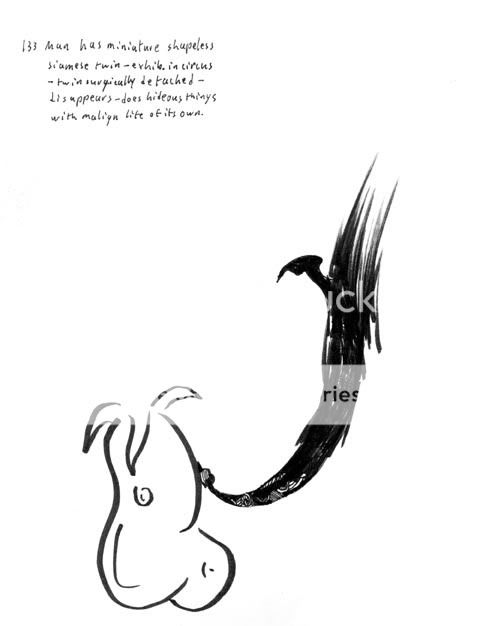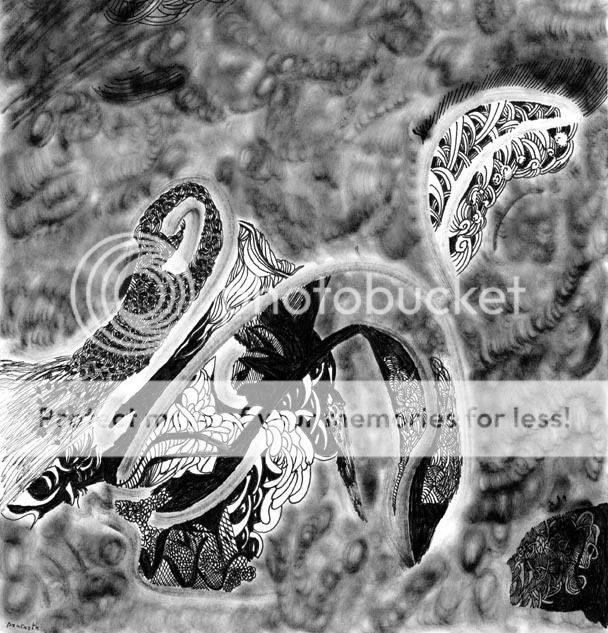Stefan Dinter, the man behind German comics company Zwerchfell Verlags, got me to write an intro for Xoth –The Unspeakable City, a new Lovecraft pasticheby Anna-Maria Jung. Here’s a bit of press info about author and book:
On ANNA-MARIA JUNG:
Anna-Maria Jung was born in Graz, Austria, where she started to draw comics during her teens. She started to study Multi-Media Arts, then went on to work at Bill Plympton‘s animation studio in NYC (for the short film
»Shut Eye«). Returning to Austria, she began to to write her master‘s thesis in Multi-Media Arts at the Fachhochschule Salzburg on the theme of »The Creation of a fantastic world, based on H.P. Lovecraft‘s Cthulhu Myth«. The Thesis deals with, amongst others, »background information on the author, the cthulhu myth and the meaning behind the stories, as well as examples of lovecraft-inspired media and a discussion of how these different kinds of work deal with Lovecraft‘s stories«. During the work on the thesis, Anna-Maria started to work on conceptional artwork for a fictional city named XOTH and its inhabitants, inspired by Lovecraft‘s creations. From this grew the idea for a comic book – XOTH, The unspeakable city.
On XOTH:
On one of his many uneventful, boring evenings, Jacop O‘Damsel, freelance nerd, drunkenly decides to fall asleep in a back alley. Bad timing, since an intergalactic Dimensional Shambler apears right there and then. And before Jacop gets the faintest chance to even be hung-over, the thing whisks him away.
Jacop awakens in XOTH, a strange world full of weird creatures – or are they unutterably blasphemous? Anyway, there are also the »Humanists«, a gang of stinky fisheads whor worship Humans and need Jacop for a certain – if unspecified – mission. And if that wasn‘t madness enough, Mayor Cthulhu orders his best killers, Nub and Shang to rub Jacop out of existence. Thanks be to the Old Ones, because Jacop finds Yen Niggurath,a nice goat-girl, who decides to help the hapless human. Together with
her, Jacop will get to the bottom of the »Ordus Humanus« affair, since – Cthulhu‘s fat ass! – he‘s in no mood to run for his life forever.
Set against the background of H.P. Lovecraft‘s Cthulhu Myth, Anna-Maria Jung tells a tall tale full of monsters, nerds, monstrous nerds and nerdy monsters. And the man from Angell Street is in there, too.
XOTH! Die unaussprechliche Stadt, an 80 page hardcover with a foreword by ill-tempered critic Noah Berlatsky is published by Zwerchfell Verlag. more on http://www.xoth-comic.net/ and http://zettgeist.blogspot.com/
——
…and because I’m a lame-ass American monoglot, and can’t read German, you now know about as much about Xoth as I do. Luckily, Stefan wanted the intro to be an intro to Lovecraft rather than to the comic per se. So anyway, the intro is below…and if you buy the book, you can see it in German too! (Which I think may be my first translated work!)
—–
Horrid Replication
H.P. Lovecraft loathed and feared degeneration with an intensity hardly distinguishable from lust. With obsessive, leering repetitiveness, his stories imagine man as a kind of vulnerable waxwork, constantly in danger of melting into a suggestively amorphous travesty of itself. In Lovecraft, there are no sexual references, no women, and virtually no dialogue. Every man is trapped in his own skull, quivering with impotent emotion as gaping atavisms engulf him, swallow him, have their way with him and discard him, leaving behind as progeny an animalistic cannibal, an undead zombie, a croaking brachian, a friable gray powder, or a slithering mass of protoplasm. Lovecraft in his actual life had very unpleasant racial views, and the spectre of miscegenation, of impure violation and alien congress, slithers through every page he wrote. Behind his constant use of adjectives like “nameless”; “unspeakable”; “inexpressible”; “indescribable” it is hard not to see a massive, leaden repression. Like the devolving narrator of “A Shadow Over Innsmouth,” Lovecraft’s horror shades ominously into fascination — a desire to slough off humanity altogether, and bathe in defilement for all eternity.
Whether Lovecraft actually desired such a fate, he’s certainly achieved it. Perhaps more than any other twentieth century writer, his work has inspired, not reverence or criticism, but twisted doppelgangers. All art tends to propagate itself, of course, whether in homoerotic Star Trek fan fiction or Jane Austen movie adaptations. But even by these standards, Lovecraft is something else. Whether you’re Stephen King, Alan Moore, or …well, me, in some of my earliest and most benighted prose efforts, the allure of Lovecraft is infinitely irresistible. Cthulhu pops up incongruously in comics, books, movies — for that matter, I’ve even got a plush Lovecraft monster doll (it’s starfish shaped, with too many eyes, and it kind of scares my four-year old.) To merely glance through one of the man’s unholy books, it seems, is to want to create a blasphemous imitation.
There are lots of reasons why it’s fun to steal from Lovecraft. His unwieldy vocabulary is addictive. Once you’ve been introduced to “Cyclopean,” “opalescent”, “bizarrerie”;” and “Archaen,” — all on one page, no less — you’re bound to start using them yourself. Similarly, his invented, unpronounceable neologisms — Cthulhu, Yog-Shothoth, Necronomicon — are both so instantly recognizeable and so ill-defined that you can’t help but want to make them your own.
Indeed, even in Lovecraft’s own stories, the names of these creatures are dropped with such forced emphasis that they seem borrowed — as, indeed, does most of the prose and plot. His tales are a glutted agglomeration of incoherent genres; faux anthropological treatises, swipes from Poe, shock-twist endings more hoarily ancient than his own Elder Gods; all tied together with looping strings of polysyllables, leaden pacing, and a keen disregard for characterization, narrative tension, or consistency. Original Lovecraft feels remarkably like pastiche, and the most perfect Lovecraft parody is simply Lovecraft — which is what makes Lovecraft parody so hard to resist.
And yet, despite their silliness, the best Lovecraft stories have a submerged emotional coherence — a deep pool of hysteria and anxiety which, at moments, overpowers the clumsy, plodding structure which seems designed more to contain than to explicate it. The narratives are filled with horrors unspoken, revelations half-revealed. In “At the Mountains of Madness”, Danforth looks back from the plane and sees something — we aren’t told what — which causes him to shriek aloud “Tekeli-li! Tekeli-li!” This is a decidedly goofy reference to Poe. And yet, at the same time, there is something meaningful and affecting in the glance backwards that causes madness. The nonsense noise and the literary reference almost seem designed to bury the core effect — the evocation of a mythical primal scene, that turns men to weeping children.
Or look at the following passage, in which, Lovecraft describes one of his patented monsters; a shoggoth.
Formless protoplasm able to mock and reflect all forms and organs and processes — viscous agllutinations of bubbling cells — rubbery fifteen-foot spheroids infinitely plastic and ductile — slaves of suggestion and builders of cities — more and more sullen, more and more intelligent, more and more amphibious, more and more imitative —Great God!
There just isn’t anything especially frightening about a rubbery fifteen-foot spheroid — I mean, what is it, a gigantic football? But preposterous as the start of the quote is, the end has an evil lyrical force in its nightmare vision of slave uprisings, of rightful rulers overthrown by indistinguishable, ungrateful, utterly unhuman underlings. It’s like a more repressed, more foaming version of Carlyle’s French Revolution.
Lovecraft (suggestively) hated Freud. But what is most compelling about his narratives is the sense that they are unavoidably Freudian — that the story’s thin, precarious consciousness is stretched above an unexplored abyss. Like Lovecraft’s characters, his readers and imitators are drawn on by the allure of undiscovered truths, unexplored passages, unnamed horrors. The stories resolutely refuse to explore their own implications; their meanings don’t reveal themselves easily or naturally, but rather slither out, half-formed, oozing a foetid miasma, before lurching back, half-seen, into the blackness which spawned them. Did you really see that? Did Lovecraft?
Perhaps…or perhaps not. Certainly, few writers have written so obsessively about the desirability of ignorance — and, especially, of self-ignorance. Anna-Maria Jung hits on something profound in Xoth when she switches the brains of Lovecraft and a Yithian. Not that Lovecraft’s work is especially alien, but it does sometimes seems written as if it’s author had deliberately asked his brain to leave the room. The stories seems disavowed by their creator — which is why so many other people have tried to claim them.
The result is invariably, to quote the master out of context, “degenerate work…coarse, bold, and wholly lacking in delicacy of detail.” But, as Lovecraft knew ( or, perhaps, tried not to know) degeneration has its own perverse attractions. So prepare to enjoy the debasement that is Xoth — and I hope it inspires you to explore the debasement that is Lovecraft as well.
——–
If you want to read more of me on Lovecraft, you can check out my review of the Eureka’s Graphics Classic comics adaptation of some of his stories. (I believe Stefan read this review, which is why he asked me to do the intro for Xoth.)
And if you’re unholy yearning is still not sated, you can see some of the art I did for an exhibit based on quotes from Lovecraft’s Commonplace book which is still shuttling around Europe as we speak:



Hiho! THis is Anna-Maria, the comic artist. Thanks for blogging on this and thanks for the very nice forword! Hopefully, one day, youll be able to read it in English :-)
Hey Anna-Maria! I hope so too…or maybe I should just learn German….
By the way: the xoth webpage exists in English now (well most of it) if you klick on the English flag in the right top corner! http://www.xoth-comic.net